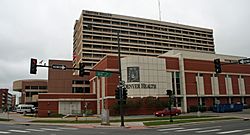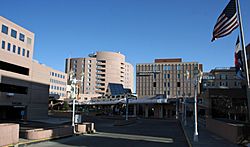Frances McConnell-Mills facts for kids
Quick facts for kids
Frances McConnell-Mills
|
|
|---|---|
| Born |
Frances Mary McConnell
July 9, 1900 |
| Died | December 28, 1975 (aged 75) |
| Other names | Frances McConnell |
| Education | University of Denver; University of Colorado Denver |
| Medical career | |
| Profession | Physician |
| Field | Toxicology |
| Institutions | Denver General Hospital St. Luke's Hospital |
| Sub-specialties | Forensic pathology |
| Research | Passive immunity |
Frances Mary McConnell-Mills (born July 9, 1900 – died December 28, 1975) was an American toxicologist. She was a true pioneer for women in science. Frances was the first woman to be named Denver's city toxicologist. She was also the first female toxicologist in the Rocky Mountains region. Many believe she was even the first female forensic pathologist in the entire United States.
Frances grew up in Colorado and first studied chemistry. She then became a high school teacher. Later, she went to medical school at the University of Colorado Denver, finishing her studies in 1925. She became an expert in toxicology and forensic pathology. This meant she often gave important evidence in many big criminal cases. Besides her work as Denver's city toxicologist, she also worked in hospitals and on important medical boards. Frances faced health challenges throughout her life, including rheumatic heart disease and losing a leg. She passed away in 1975. After her death, she was honored by being added to the Colorado Women's Hall of Fame.
Contents
Early Life and Education
Frances Mary McConnell was born in 1900 in Monument, Colorado. Her father was a doctor and a pharmacist. He often took young Frances with him when he visited patients. This might have sparked her interest in medicine early on.
To attend Colorado Springs High School, Frances lived with her aunt and grandfather. She graduated at just 15 years old. She earned a full scholarship to the University of Denver. By age 17, she had earned a bachelor's degree. At 19, she received a master's degree in chemistry. This made her the youngest person to get a master's degree from the university at that time. In 1919, she started teaching chemistry, biology, geometry, and trigonometry at Englewood High School.
In 1920, Frances was accepted into the University of Colorado School of Medicine. Even though her father had paid for 17 men to go to medical school, he refused to pay for her. He thought medicine was "too hard a life for a woman." But Frances was determined! She paid for her own medical school by working as a musician in local places, a tutor, and a lab assistant. In November 1925, she married David L. Mills, a lawyer. They had a daughter the next year. Frances added "Mills" to her name, becoming McConnell-Mills. However, she kept using her maiden name, Frances McConnell, for her professional work. She did this to keep her work life separate from her family life.
A Trailblazing Career
Frances graduated as a Doctor of Medicine in 1925. She then completed an internship at Denver General Hospital. Soon after, she became a toxicologist in the coroner's office at the same hospital. This made her the first female toxicologist in the Rocky Mountains area. In 1926, she was named Denver's city toxicologist. The next year, she became an assistant pathologist. Her appointment as city toxicologist was a big step, making her the first woman to hold that important job.
Frances's main work involved analyzing poisons and blood samples. She often testified in criminal cases as an expert witness. Her job was to figure out how someone died, especially when poisoning was suspected. For example, in 1930, she investigated the death of a ten-year-old girl in Denver. It was a very famous and talked-about case. Frances first thought the girl was poisoned. But then she found blood stains in the family car. Her evidence helped lead to the girl's stepmother being found guilty.
In 1936, Frances testified in a case against Joe Arridy. She found tiny fibers from the crime scene under his fingernails. Her testimony was important in that case. She also discovered that a man named Georg Obendoerfer had died from a large dose of arsenic. This led to more investigations. It was confirmed that Anna Marie Hahn had killed him and other men in the same way. Frances testified at Hahn's trial. A court reporter once wrote that Frances "has gained a national reputation" for her blood analysis work. She is also believed to be the first female forensic pathologist in the United States. Even though she worked on many public cases, Frances kept her private life very quiet. She only gave one interview during her whole career.
Beyond her work in toxicology, Frances did a lot of lab research. In the 1930s and 1940s, she researched passive immunity. She developed special serums for illnesses like scarlet fever, polio, the common cold, and acne. She even used these on her own family members. She also invented a hair rinse called "Noreen" while working for a doctor. This product was sold until the 1990s!
In 1941, Frances became the director of the lab department for the Colorado State Board of Health. She later started a school at Denver General Hospital. This school trained new medical technologists, especially women. She continued to learn, studying advanced serology at the University of Michigan in 1941. In 1943, she studied surgical pathology in Chicago. After this, she left the Board of Health. She then became a lab director and pathologist at St. Luke's Hospital in Denver. She had to leave St. Luke's in 1944 due to illness. After she recovered, she returned to Denver General Hospital as its lab director. She continued to work on criminal cases until 1948.
In the 1950s, Frances worked with Dr. Florence R. Sabin. They created an exam for the Colorado State Board of Basic Sciences. This exam helped decide who could get licenses to practice health science. Frances was appointed to the Board in 1956. She was the only woman on the Board at that time. She served there until 1975.
Health Challenges and Passing
Frances faced health problems throughout her life. At age 20, she got rheumatic fever, which later led to rheumatic heart disease. In 1944, she needed emergency surgery for appendicitis. After the surgery, she developed a blood clot in her right leg. Sadly, her leg had to be removed above the knee. She received a prosthetic leg, which she playfully called "Matilda." Later in life, she used a wheelchair.
After her husband passed away in 1967, Frances lived alone. She kept working almost until the very end of her life. She held different roles on the Board of Basic Sciences. She also worked in an allergy practice and as a consultant for the Denver Poison Center. She passed away in December 1975 at St. Luke's Hospital in Denver. She was 75 years old.
Legacy and Recognition
A year before she passed away, in December 1974, Frances received an award. The University of Colorado Medical School recognized her as a graduate of 50 years. She was also one of only two women in Colorado at that time who had practiced medicine for 50 years.
In 1996, Frances was inducted into the Colorado Women's Hall of Fame. This is a great honor. In 1999, her daughter, Jeanne Varnell, published a book. It was called Women of Consequence: The Colorado Women's Hall of Fame. This book included biographies of Frances and 58 other women in the Hall of Fame. Jeanne had originally planned to write only about her mother. But her editor encouraged her to write about all the women.



